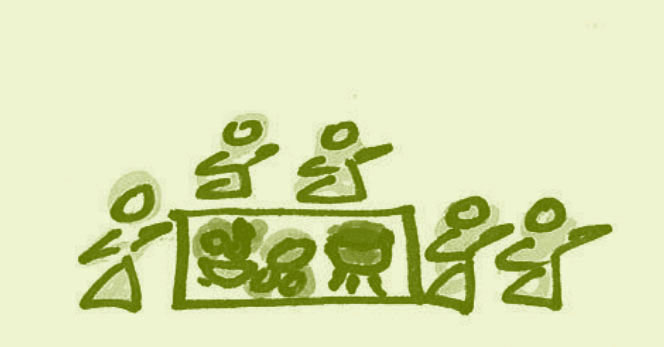The Social Importance of Sharing Our Stories
Story sharing has been a central approach used by the Pan-Valley Institute when engaging people in popular education processes. Here we share our observations of why story telling is important. By providing a safe space for people to share their stories, you set the stage for the following things to occur:
• Give meaning and value to what people communicate.
• Give quiet people the opportunity to speak up, and dominant people the opportunity to listen and be sensitive to others.
• Allocate time to listen to other peoples’ problems.
• Learn different ways of doing things and/or exercise leadership.
• Learn to value our own knowledge and leadership capacity.
• Learn to develop the capacity of using our realities as reflection and analysis tools.
• Build capacity to learn from others.
• Build a sense of community by listening and valuing the life experiences of others.
• Hearing becomes listening only when we pay attention to what is said and follow it very closely.
• Listen to causes of problems, and associate a problem with a cause.
• See the causes and reasons of the problems and what can be done about them.
• Get insight and understating of people and community problems as they talk it out.
• Be understanding of others.
“Through a process of cultural sharing and learning, we begin to realize how our stories are intertwined, regardless of whether our home country is Mexico or Laos. We have seen the power of relating to one another unleash when we had the chance to sit down together, learn to trust one another and simply talk.”
~Estela Galvan


Principles
• Listening, emotions and surroundings all contribute to different ways of communicating

Tips
• Give people time to be ready to share stories
• Some stories are painful and take time for people to be ready to sharers
References
• The Theory Behind Our Work booklet
• Popular Education tools
• Our Story: Share, Listen and Learn Tool
• Facilitating a Story Circle Tool
• Our Story: Share, Listen and Learn
Facilitating a Story Circle
In working with communities with strong oral traditions, we have found story circles to be a powerful and effective approach for engaging immigrants and refugees in dialogue about issues that matters to them, for sharing their stories, and for building relationships and understanding of each other. This approach was largely used by the participants of the Tamejavi Cultural Organizing Fellowship Program as an approach to engage people in dialogue while conducting a community assessment.
The Pan-Valley Institute learned about story circles during the opening of the first Tamejavi Festival when we had the privilege to participate in a story circle facilitated by John O’Neal, co-founder of the Free Southern Theater and Junebug Productions, based in New Orleans. In 2014, we invited Stephanie McKee-Anderson, current executive artistic director of Junebug Productions, to facilitate a story circle workshop for the second cohort of participants of the Tamejavi Cultural Organizing Fellowship Program. This tool is developed from the notes of that particular workshop.
A. There are four parts to the story circle process:
1. Introduction and guidelines explanation
2. Story circle is a space for listening and telling our stories; it is more important to listen than tell
3. Crosstalk: After everyone in the circle has told their story, there is an opportunity to talk to each other and ask questions4. Transformative action: Action that come after story circle
B. Atmosphere
Sitting in a circle allows participants to see each other, make eye contact, and gives a sense of togetherness
C. Important guidelines
• Always introduce everyone and tell the purpose of the story circle
• Be transparent about the theme of the circle
• Only one person tells a story at a time. Limit each speaker to about three minutes, as this time limit encourages people to be concise and to have a beginning, middle and an end to their story. Use a timekeeper and honor each person’s time limit.
• We plant the seed, give a story, and continue to talk and grow the seed
• The circle is not just representative of community; it represents the democratic process
• Go clockwise around the circle as it will ensure no one is missed
• Silence is an option, but let it be from a place of reflection and not of fear
• Be present in sharing about you, and remember that reciprocity is about giving and receiving
• Take a moment to sit and reflect on the stories you heard
D. Cultural Protocols
It is important that the facilitator know the group and how to approach it; no one circle will be the same as they are made of unique participants. It may be helpful for the facilitator to share his or her story first to make participants comfortable and encourage them to follow suit.
E. Transformative Action
End the story circle with an opportunity for people to translate what they learned into transformative action. Challenge them to think about what they’re going to do with this new information.
Source: http://junebugproductions.org


Principles
• Provide a space where people feel free to share their experiences

Tips
• Refer to “Important Guidelines” section of this tool
References
• The Theory Behind Our Work booklet
• Tamejavi Cultural Organizing Fellowship Program section
• Tamejavi Festival section
The Social Importance of Sharing Our Stories
The activity in this tool provides steps for constructing compelling community stories.
Instructions: Come prepared to share a real-life story about a time when your community faced a large challenge; include details about the specific obstacles you faced and how that problem was or was not solved. Elaborate on the people that helped try to solve the problem and what they specifically did that worked or didn’t work in making the desired changes. Each participant will have eight minutes to share their story.
COMMUNITY CHALLENGES: Tell about a time when your community faced a major problem that upset many people.
SETTING: What else contributed to this problem or challenge in your community? Examples could include the year, political climate, relevant history or cultural perspectives.
EVENT: What actually happened that created the problem that your community felt they needed to address: a political decision, a natural disaster, a long-standing problem?
CHARACTERS: Who were the characters involved: who did you disagree with, who did you need to approach to solve the problem, who took leadership from your community, what other people ended up getting involved?
ACTIONS: What did your community leader or leaders do to solve this problem: Did they confront the situation and challenge the power? Inspire other to act together? Come up with creative new idea? Develop a good plan and followed through? Something else? Be as specific as possible.
OUTCOME: What was the outcome or effect of the challenge your leadership took on?
LEARNING: What did you learn from this experience?


Principles
• Our role is to be good listeners, provide tools, facilitate process and draw out peoples’ knowledge

Tips
• You can frame your story however works best for you. Do not feel you have to use all of the questions included.
Please note that this is not a written exercise, but rather an oral narrative as a means to share, listen and learn from each other’s experiences.
References
• The Theory Behind Our Work booklet
• Facilitating a Story Circle Tool
• Tamejavi Festival section
• The Social Importance of Sharing Our Stories Tool
Facilitating Multilingual Conversations
This tool shares key recommendations for facilitating multilingual conversations.
Background
Since the Pan Valley Institute’s inception, we took on the challenge of bringing together groups of people with diverse ethnic and cultural backgrounds and set a goal of facilitating one conversation in many languages. Removing language as a communication barrier and instead allowing for multilingual conversations builds meaningful and respectful interethnic relationships. To help foster these relationships, we decided to invest in equipment that allows for simultaneous interpreting.
Why is it important to provide interpreters?
We place a high value on interpreting skills and believe that being bilingual does not necessarily translate to being a skilled interpreter. We strongly recommend hiring professional interpreters when facilitating multilingual dialogues; particpants will be grateful and have the confidence needed to be involved in the dialogue.
Key Recommendations
• Contact an interpreter who is well-established and that is familiar with your work and the communities you work with.
• Meet with the interpreter before your meeting or event to go over any documents, the agenda, provide background information, etc. so they are familiar with the program before it begins.
• Because interpreting can add a significant amount of time to the program,
it is recommended that the interpreting be simultaneous.
• When contacting the interpreter, tell him or her they will be doing simultaneous interpreting and using equipment, as not all interpreters are comfortable or have experience doing this.
• Prepare the interpreting equipment the day before to make sure everything is working and the equipment is fully charged.
• Have the interpreter arrive at least 30 minuntes before the event to allow time to get familiar with the interpreting equipment.
• All interpreters must use the equipment to avoid having to speak too loudly to eliminate the person in need of the service not hearing correctly and to eliminate other potential technical difficulties.
• At the start of your event, explain the logistics of simultaneous interpreting to the audience.
Simultaneous Interpreting With More Than Two Languages
• Each interpreter is assigned a channel; i.e. Spanish (CH1), English (CH2), Arabic (CH3) and Hmong (CH4).
• One option for interpretation is when someone is speaking in Spanish, the Spanish interpreter will be in channel one and the rest of interpreters should switch to channel one to listen to the English interpretation.
• The interpreters will then switch to their assigned channels to share what has been said in the language they are interpreting to.
• Another option is when a person is speaking in their native language, the interpreter for that language translates it to English through a microphone rather than the interpreting equipment. By doing this, the rest of the interpreters will avoid having to switch between channels.
“One conversation in many languages”
-one aspect of PVI’s mission


Principles
• We are committed to enabling the participatory learning of, and communication among, people who speak different languages.
• We promote the building of positive, respectful relationships across lines of culture, gender, race, language, literacy, age, faith and other differences. We recognize the importance of sharing common experiences, challenges and differences to find a shared agenda as the basis for common understanding and action.

Tips
• Tips are included in the tool’s recommendations.
References
• Guiding Values and Principles
• The Social Importance of Sharing Our Stories Tool

